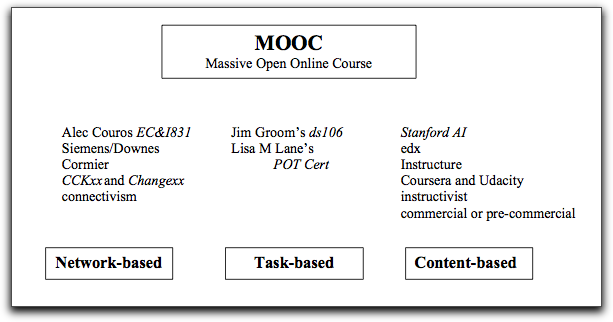[Originally posted at the Program for Online Teaching website, May 2015]
 According to Wikipedia, a “best practice” is one that “has consistently shown results superior to those achieved with other means, and that is used as a benchmark”. The page also notes that it is considered by some to be a business buzzword “used to describe the process of developing and following a standard way of doing things”.
According to Wikipedia, a “best practice” is one that “has consistently shown results superior to those achieved with other means, and that is used as a benchmark”. The page also notes that it is considered by some to be a business buzzword “used to describe the process of developing and following a standard way of doing things”.
Without knowing this, I became hostile to the term “best practices” about online teaching early on, for a number of reasons. It hadn’t been around that long, and I couldn’t help but notice that most of the people touting “best practices” were not, themselves, practitioners. And yet, the literature abides:
- Hanover Research Council, Best Practices in Online Teaching Strategies (2009)
- Judith V Boettcher, Ten Best Practices for Teaching Online (2006-11)
- Faculty Focus, 10 Principles of Effective Online Teaching: Best Practices in Distance Education
- Brown University, Best Practices for Teaching Online
- Penn State, Best Practices and Expectations for Online Teaching
And that’s just the first few entries in Google.
So what’s wrong with all this?
Such lists, which vary from each other, can easily become prescriptive.
Taking the Penn State list as an example, everything sounds, at first, quite reasonable. Everyone would appreciate the need for the teacher to monitor submissions, but it is apparently a “best practice” to “remind them of missed and/or upcoming deadlines”. The professor is thus responsible for providing reminders, even if the course is already set up with clearly established deadlines. Perhaps I would be expected to send out text messages every week to remind them of every quiz, even if my pedagogy were designed to encourage them to monitor their own workload.
“Provide meaningful feedback on student work”, it says, and tells us not to say “good job”. This could be interpreted in a number of ways. With my weekly assignments, it could require me to provide full textual feedback to every student every week, which would be impossible. Instead, I use a qualitative scale.
I notice that the Penn State list includes matters of college policy rather than pedagogy, all mixed in to “best practices”.
Or there’s this example:
- Moving Online: A Best Practice Approach to Achieving a Quality Experience for Online Education (2014)
Here the best practices are all put together into a template used by all teachers in the system, in order to reduce “the cognitive stress students report in navigating educational materials”. And yet many students want similar systems as a convenience, regardless of the learning experience the professor is trying to create. We are heading toward the “canned” course model, where academic freedom runs a distant second to standardization.
 There is a fine line between “best practices” (meaning some good ideas that you might use), and “college x’s best practices” (the rules which you must follow). The buzz-phrase makes it sound as those these practices have been proven to be “best”, when what’s best is actually affected by instructor personality, discipline, pedagogy, technical knowledge, and other variables. I’ve seen very little agreement on what constitutes what’s best in any sort of teaching, much less online teaching.
There is a fine line between “best practices” (meaning some good ideas that you might use), and “college x’s best practices” (the rules which you must follow). The buzz-phrase makes it sound as those these practices have been proven to be “best”, when what’s best is actually affected by instructor personality, discipline, pedagogy, technical knowledge, and other variables. I’ve seen very little agreement on what constitutes what’s best in any sort of teaching, much less online teaching.
Limited knowledge, as usual, leads to efforts to reduce the cognitive load, not of students, but of instructors. It is much easier to follow administratively-led best practices than to determine how to develop ones own online pedagogy. For many faculty, it’s more comfortable to do what you’re told than to develop your own way. We struggle with this with our students – developing inquiry-based exercises and problem-based learning can be difficult when students insist they want to just be told what they’re supposed to learn.
I think it’s wrong to encourage a limited view of teaching online, supporting it with selected (and often very small sample) “studies”, and calling it “best practices”. Doesn’t seem like good practice to me.
Images by Barry Dahl, cc Flikr
 I have written before about the challenges of Learning Management Systems, and how they
I have written before about the challenges of Learning Management Systems, and how they 




 Another premise is that open is always better. Closed courses are not just manifestations of bureaucratic and administrative attempts to institute efficiency and focus on outcomes, although they are that too. Closed courses provide a sense of protection for students and professors, just like the closed classroom door does. Even apart from FERPA (which isn’t about what most people think it’s about anyway), there is an argument to be made that academic freedom, student participation, and the use of copyrighted material, is much easier and “freer” in a closed silo.
Another premise is that open is always better. Closed courses are not just manifestations of bureaucratic and administrative attempts to institute efficiency and focus on outcomes, although they are that too. Closed courses provide a sense of protection for students and professors, just like the closed classroom door does. Even apart from FERPA (which isn’t about what most people think it’s about anyway), there is an argument to be made that academic freedom, student participation, and the use of copyrighted material, is much easier and “freer” in a closed silo. So it’s not that the points Audrey makes aren’t valid – she’s great and I love her work. And I love the Domain of Ones Own idea, and WordPress.org, and open courses (I teach some) and the open web and the push to keep it open. It’s just that anyone who’s relying on today’s technology – any of today’s technology – needs to think again. Our work, as Audrey points out, is not secure in the hands of corporations, or, frankly, educational institutions. It needs to be stored, or at least archived, in our own hands. That’s the whole idea behind the e-portfolio market – except that our portfolios should also be on our hard drives.
So it’s not that the points Audrey makes aren’t valid – she’s great and I love her work. And I love the Domain of Ones Own idea, and WordPress.org, and open courses (I teach some) and the open web and the push to keep it open. It’s just that anyone who’s relying on today’s technology – any of today’s technology – needs to think again. Our work, as Audrey points out, is not secure in the hands of corporations, or, frankly, educational institutions. It needs to be stored, or at least archived, in our own hands. That’s the whole idea behind the e-portfolio market – except that our portfolios should also be on our hard drives.




